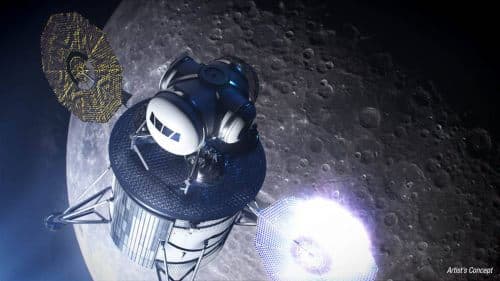The return to the moon will also be open to private entities
Enough hastening our return to the moon, we are changing our traditional ways of doing business. We will expedite everything that can be obtained in the private market, from procurement to partnership in hardware development and even to launches," said Marshall Smith, director of the Manned Lunar Exploration Program at NASA Headquarters.

NASA has chosen 11 companies to research and create a prototype of manned landers for the "Artemis" lunar exploration program, under which two American astronauts - the first woman and the 13th man - will be placed on the moon in 2024, and towards the establishment of a permanent manned point on the moon starting in 2028.
"To accelerate our return to the moon, we are changing our traditional ways of doing business. We will expedite everything that can be obtained in the private market, from procurement to partnership in hardware development and even to launches," said Marshall Smith, director of the Manned Lunar Exploration Program at NASA Headquarters. "Our team is excited to get back to the moon as quickly as possible, and our public-private partnerships to explore manned landing systems are an important step in that process."
The selected companies will research and develop a prototype during the next six months, for various components required for a manned flight to the moon, and especially for the orbit phase, the descent to the landing and the landing itself.
The plan proposed by NASA is to launch astronauts in a manned landing system that includes components for transfer to orbit around the moon and back to it. NASA is also looking into refueling capabilities to ensure that these systems can be reused.
The total budget amount that will be allocated to all companies is 45.5 million dollars. Since NextStEP (NASA's program for cooperation with the industries in the development of technologies) is a joint public and private program, the companies are required to invest at least 20% of the total cost of the project. This partnership will reduce costs for the taxpayer and encourage private investments in the lunar economy.
The winners are:
- Aerojet Rocketdyne: Transfer Vehicle Research
- Blue Origin: Research and Prototype of One Landing Vehicle
- Boeing: XNUMX lander research, XNUMX prototypes, XNUMX lunar rover research and a prototype of such a vehicle, refueling research and a refueling spacecraft prototype
- Dintica: one amphibious vehicle, five prototypes
- Lockheed Martin – Littleton, Colorado: One component study, four prototypes, one transfer-to-orbit spacecraft study, and one refueling study
- Masten Space Systems: One prototype
- Northrop Grumman: One Lander Study, Four Prototypes, Fueling Element Study and One Prototype
- Orbitbeyond: two prototypes
- Sierra Nevada: XNUMX component study, XNUMX prototype, XNUMX vehicle study and prototype
- SpaceX – One Component Research
- SSL – refueling research and building a prototype of a refueling component
To speed up the work, NASA will allow companies to begin operations while the contract is being negotiated.
"We are taking steps that will allow us to begin development as quickly as possible, including starting work on NextStEP while we are still negotiating," said Greg Chavers, director of manned landing systems development at NASA's Marshall Space Flight Center in Huntsville, Alabama. "We are eager to gather rapid feedback from industry on the Manned Landing System requirements."
This summer, NASA is going to announce the requirements for landing humans on the moon in 2024, and will leave it to the industry to determine which technologies to use and develop hardware and carry out integration.
"This new approach does not prescribe a specific design or number of components for the manned landing system," Chavers said. "NASA needs a system to land our astronauts on the surface and bring them home safely, and we leave many of the small details to our commercial partners."
For a message on the NASA website
More of the topic in Hayadan:

3 תגובות
If we divide these 45 million into 11 companies, each company receives an average of 4 million dollars. which in American terms is hardly the salaries of a small planning and development team for one year at most. And not too much can be done about it. (perhaps formulate a preliminary outline of planning) so that it seems mostly as a grain of sand in the eyes, and not as a serious reference.
Welcome to Trump Mind.
According to the extreme capitalists, the government should do nothing.
45 million! big spenders.